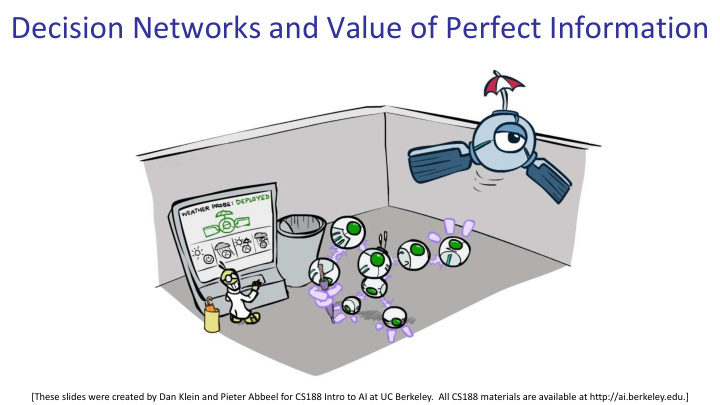



Decision Networks and Value of Perfect Information [These slides were created by Dan Klein and Pieter Abbeel for CS188 Intro to AI at UC Berkeley. All CS188 materials are available at http://ai.berkeley.edu.]
Decision Networks
Decision Networks Umbrella U Weather Forecast
Decision Networks MEU: choose the action which maximizes the expected utility given the evidence Can directly operationalize this with decision networks Bayes nets with nodes for utility and Umbrella actions Lets us calculate the expected utility for U each action Weather New node types: Chance nodes (just like BNs) Actions (rectangles, cannot have parents, act as observed evidence) Forecast Utility node (diamond, depends on action and chance nodes)
Decision Networks Action selection Instantiate all evidence Umbrella Set action node(s) each possible way U Calculate posterior for all Weather parents of utility node, given the evidence Calculate expected utility for each action Forecast Choose maximizing action
Decision Networks Umbrella = leave Umbrella U Umbrella = take Weather A W U(A,W) W P(W) leave sun 100 sun 0.7 leave rain 0 rain 0.3 take sun 20 Optimal decision = leave take rain 70
Decisions as Outcome Trees {} Umbrella Weather | {} Weather | {} U Weather U(t,s) U(t,r) U(l,s) U(l,r) Almost exactly like expectimax / MDPs What ’ s changed?
Example: Decision Networks A W U(A,W) Umbrella = leave Umbrella leave sun 100 leave rain 0 take sun 20 U take rain 70 Umbrella = take Weather W P(W|F=bad) sun 0.34 rain 0.66 Forecast Optimal decision = take =bad
Decisions as Outcome Trees Umbrella {b} U W | {b} W | {b} Weather U(t,s) U(t,r) U(l,s) U(l,r) Forecast =bad
Ghostbusters Decision Network Demo: Ghostbusters with probability Bust U Ghost Location … Sensor (1,1) Sensor (1,2) Sensor (1,3) Sensor (1,n) … Sensor (2,1) … … Sensor (m,n) Sensor (m,1)
Value of Information
Value of Information Idea: compute value of acquiring evidence D O U Can be done directly from decision network DrillLoc a a k U a b 0 Example: buying oil drilling rights O P b a 0 Two blocks A and B, exactly one has oil, worth k OilLoc a 1/2 You can drill in one location b b k Prior probabilities 0.5 each, & mutually exclusive b 1/2 Drilling in either A or B has EU = k/2, MEU = k/2 Question: what ’ s the value of information of O? Value of knowing which of A or B has oil Value is expected gain in MEU from new info Survey may say “ oil in a ” or “ oil in b, ” prob 0.5 each If we know OilLoc, MEU is k (either way) Gain in MEU from knowing OilLoc? VPI(OilLoc) = k/2 Fair price of information: k/2
VPI Example: Weather A W U MEU with no evidence Umbrella leave sun 100 U leave rain 0 take sun 20 MEU if forecast is bad Weather take rain 70 MEU if forecast is good Forecast Forecast distribution F P(F) good 0.59 bad 0.41
Value of Information {+e} Assume we have evidence E=e. Value if we act now: a P(s | +e) Assume we see that E ’ = e ’ . Value if we act then: U {+e, +e ’ } a BUT E ’ is a random variable whose value is unknown, so we don ’ t know what e ’ will be P(s | +e, +e ’ ) U Expected value if E ’ is revealed and then we act: {+e} P(+e ’ | +e) P(-e ’ | +e) {+e, +e ’ } {+e, -e ’ } a Value of information: how much MEU goes up by revealing E ’ first then acting, over acting now:
VPI Properties Nonnegative Nonadditive (think of observing E j twice) Order-independent
Quick VPI Questions The soup of the day is either clam chowder or split pea, but you wouldn ’ t order either one. What ’ s the value of knowing which it is? There are two kinds of plastic forks at a picnic. One kind is slightly sturdier. What ’ s the value of knowing which? You ’ re playing the lottery. The prize will be $0 or $100. You can play any number between 1 and 100 (chance of winning is 1%). What is the value of knowing the winning number?
Value of Imperfect Information? No such thing Information corresponds to the observation of a node in the decision network If data is “noisy” that just means we don’t observe the original variable, but another variable which is a noisy version of the original one
VPI Question VPI(OilLoc) ? DrillLoc U VPI(ScoutingReport) ? Scout OilLoc VPI(Scout) ? Scouting Report VPI(Scout | ScoutingReport) ? Generally: If Parents(U) Z | CurrentEvidence Then VPI( Z | CurrentEvidence) = 0
Recommend
More recommend